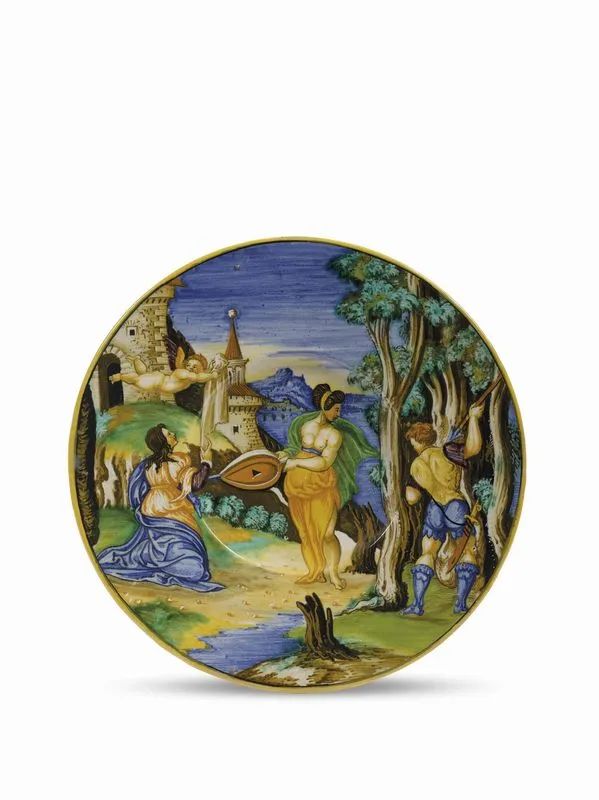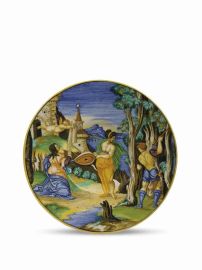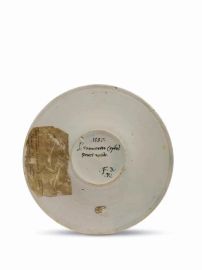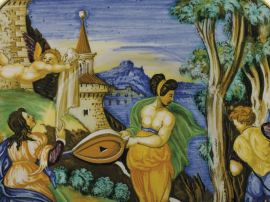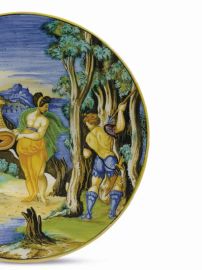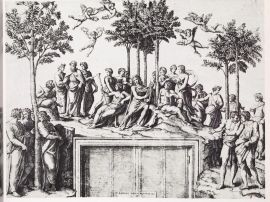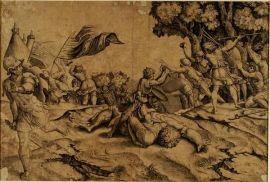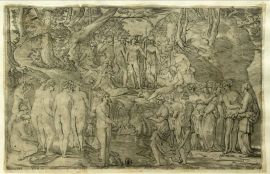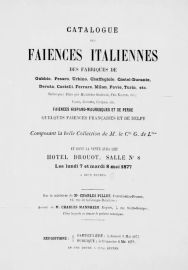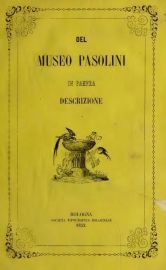DISH, URBINO, FRANCESCO XANTO AVELLI, 1537
DISH
URBINO, FRANCESCO XANTO AVELLI, 1537
Polychrome earthenware painted in two shades of green, cobalt blue, yellow, yellow-orange, brownish manganese and tin white.
Diam. cm 26,2, foot diam. cm 9,5, high cm 2
On the back, inscription: 1537./L’i[n]avvertito Cephal/Procri uccide./.F.X./.R.
An old tag on the back reads: Vente de la collection de M. le Conte G. de Larderel/5 e 6 mai 1877. N. [21] du catalogue/comm. pr. Ch. Pillet – Expert Ch. Mannheim.
Provenance
Pasolini Collection, Faenza;
Larderel Collection, Paris;
Private Collection, Paris;
Private Collection, Milan
Literature
L. Frati, Del Museo Pasolini in Faenza. Descrizione, Bologna 1852, p. 15 no. 59;
Catalogue des Faiences Italiennes… Composant la belle Collection de M. le C.te G. de L., Paris 1877, p. 8 no. 21;
E.P. Sani, Per un catalogo delle opere attribuibili a Xanto: una ricognizione sulla sua produttività e sul suo complesso apparato figurativo, linguistico ed erudito, Faenza 2007, p.187; 192 figg. 9a, 9b, in “Faenza” XCIII (2007), no. IV-VI, pp. 181-198;
E.P. Sani, List of works by or attributable to Francesco Xanto Avelli, p. 199 no. 334, in J.V.G. Mallet, Xanto. Pottery-painter, Poet, Man of the Italian Renaissance, exhibition catalogue, Wallace Collection, London 2007
The dish presents a deep cavetto and a wide, gently sloping rim and stands on a short foot without footring. The use of enamel is abundant and brilliant with green traces on the back of the dish. The painter made a large and skilful use of polychromy and, in particular, of pigments with cold tones as evident in the various shades of green, blue and light blue. For the dresses of the figures the artist chooses the yellow-orange colour while for the architectural elements he prefers light colours and thin brushstrokes to better highlight the enamelled background. The tin-white touches illuminate the faces of the figures and contribute to give depth to the landscape.
The scene depicts an uneven and diversified landscape: a small wood of trees can be seen on the right of the scene, while a broken tree trunk stands opposite; an arched building with a high pinnacled tower completes the scene on the left leaving a landscape with mountains to fill the rest of the background. In the centre a female figure is blowing in a bellows towards a kneeling woman with joined hands, looking up to the sky. Hidden in the trees, a young man is raising a spear to throw it. The brownish manganese inscription on the back of the plate explains: L’i[n]avvertito Cephal / Procri uccide.
This scene describes the myth of Cephalus and Procris, recounted by Ovid in the "Metamorphoses" (Metamorphosis, VII, 661-865) and often reproduced in paintings and miniatures. This myth also gained great success thanks to the adapted version with happy ending, performed on the stage by Niccolò da Correggio on the occasion of a noble wedding in Ferrara at the end of the fifteenth century.
The story deals with the unfortunate love of Cephalus and Procris caused by jealous deities: after numerous betrayals and difficulties, the two spouses finally meet again, but the jealousy of Procris towards the goddess Aurora, reason of their first separation, leads the woman to follow her husband during a hunt, suspecting his unfaithfulness. The doubts are aroused by some rumours that the man has entrusted the wind to send for a certain breeze, "Aura", to come and soothe him from the strains of hunting; Cephalus, instead, invokes the wind to cool him when he is hot and tired. The young man, armed with an unerring spear, thinking that some wild animal is hiding in the bushes, throws his weapon towards the sound, accidentally wounding his wife.
The composition by Xanto Avelli appears, as usual, intense and allusive. In fact, the central symbolic figure of the woman blowing in a bellows can be interpreted in two different ways: on the one side, she makes the rustling sound that causes the deadly launch of Cephalus, and on the other side, she embodies the Fame reporting the misunderstood words of Cephalus to his kneeling bride, blinded by Love that is covering up her eyes with a veil.
As often happens in his works, this majolica master craftsman of Rovigo often recurred to engravings, as we can see in our dish. The central figure, one of the most frequently depicted by this painter, is a copy inspired by one of the young girls (see fig. 1) of Giangiacomo Carraglio's engraving depicting The Contest between the Muses and the Pierides by Rosso Fiorentino (Bartsch 28, p. 186, no. 53). The figure of Cephalus is, instead, drawn from a figure in the background (see fig. 2) of the engraving of Marcantonio Raimondi depicting David Slaying Goliath by Raphael (Bartsch 27, p. 19, no. 10-I.12) while that of Love is a copy of one of the putti (see fig. 3) of the engraving Parnassus of Marcantonio Raimondi by Raphael (Bartsch 26, p. 244 no. 247). The source of Procris' figure has not been identified yet, even if it also appears on a plate, dated between 1535 and 1540, depicting Saint Catherine of Alessandria, attributed to Francesco Xanto Avelli and held in the Museum of Ecouen (inv no. ECL 2344).
The myth of Cephalus and Procris was also represented in two other works, confirming the success of the Ovidian myth in the workshop of Xanto in Rovigo. The first plate of secure attribution to Xanto Avelli is held at the Metropolitan Museum of Art of New York (inv. n. 27.97.41) and bears on the back the black inscription: “.1533./l’inaveduto Cephal/procri uccide./Nel .VII. libro dOuidioMet:/.fra:Xanto. A./Rovigiese I/Urbino”. It shares with our dish the same source of inspiration, as evident in the young Cephalus, who is, however, more similar to the original engraving in comparison to the more richly dressed figure in our plate. The second plate, dated about 1532, was originally in the set of dishes of Leonardi and is now held in the Museum of Pesaro (Inv.C.S. 155). It bears on the back the inscription "de Aurora e Cefalo", probably ascribable to Nicola di Urbino's hand. The compositions of these dishes differ, however, in the narrative choice, as well as in the representation and position of the figures in the scene and result in different interpretations of the subject. In our dish the mature style of the artist becomes more elaborate and standardized.
This dish was analysed and published by Elisa Paola Sani in occasion of the conference on Francesco Xanto Avelli at the Wallace Collection of London in 2007 and then included in the exhibition catalogue among the works attributed to the painter. The scholar suggested that the dish belonged to the Pasolini Collection of Faenza and in the catalogue (see fig. 4) in the chapter Lavori dell’epoca buona con indicazione dell’artefice. Di Francesco Xanto Rovigino vasaio di Urbino (Works of good epoch with attribution to the author. Of Francesco Xanto Rovigino potter of Urbino) at number 59 quotes: "Another very beautiful [dish], depicting Cephalus, who accidentally kills Procri. Rovigo. 1537 ". An old label on the back of the plate suggests instead that the dish passed from the Larderel Collection in Paris and was then auctioned at Hotel Drouot in 1877 (see fig. 5).

